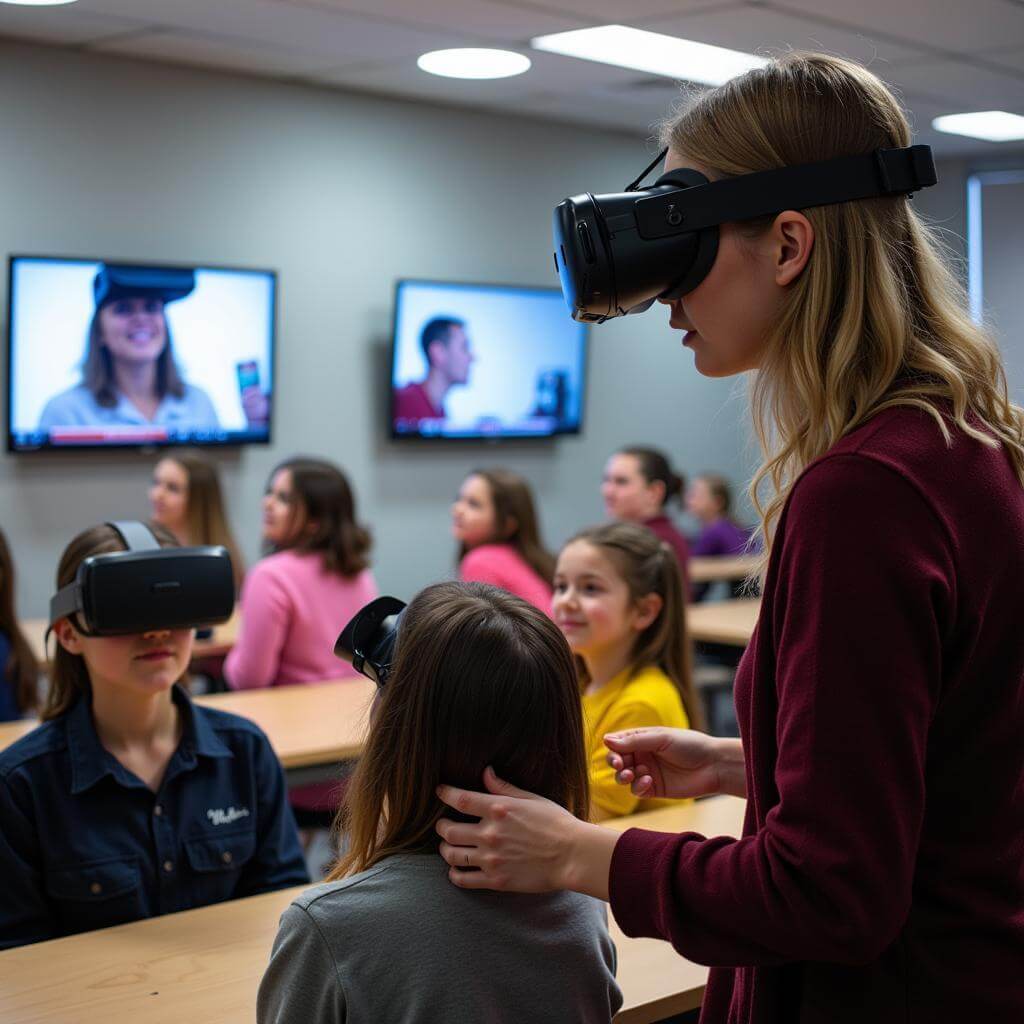As an experienced IELTS instructor, I’m excited to share with you a comprehensive reading practice that explores how technology is being leveraged to teach empathy and compassion. This topic not only aligns with current educational trends but also provides an excellent opportunity to enhance your IELTS reading skills.
How digital storytelling promotes cross-cultural understanding is just one example of how technology is revolutionizing empathy education. Let’s dive into a full IELTS Reading test that will challenge your comprehension skills while exploring this fascinating subject.
Passage 1 – Easy Text
The Digital Empathy Revolution
In recent years, educators and technologists have been collaborating to address a critical gap in traditional education: the teaching of empathy and compassion. As our world becomes increasingly interconnected, the ability to understand and share the feelings of others has never been more crucial. Innovative digital tools are now at the forefront of this educational revolution, offering new ways to foster emotional intelligence and social awareness.
One of the most promising technologies in this field is virtual reality (VR). By immersing students in simulated environments, VR allows them to literally “walk in someone else’s shoes.” For example, a VR experience might place students in the role of a refugee, allowing them to experience the challenges and emotions associated with forced displacement. This visceral, first-person perspective can create a deeper emotional connection than traditional teaching methods.
Another powerful tool is artificial intelligence (AI)-driven chatbots. These sophisticated programs can engage students in conversations about emotions, providing a safe space to practice empathy without the fear of real-world consequences. Some chatbots are designed to mimic individuals from different cultures or backgrounds, helping students develop cross-cultural empathy and understanding.
The use of role-play in teaching empathy has been enhanced through digital platforms, allowing for more diverse and immersive experiences. Online role-playing games and simulations can present complex scenarios that require empathetic decision-making, fostering emotional growth in a controlled environment.
Social media, often criticized for its negative impact on empathy, is being repurposed as a tool for compassion education. Carefully curated social media campaigns can expose students to diverse perspectives and stories from around the world, encouraging them to consider viewpoints different from their own.
As these technologies continue to evolve, their potential to revolutionize empathy education grows. However, it’s important to note that technology alone is not a panacea. The most effective approaches combine these digital tools with traditional face-to-face interactions and guided discussions, creating a holistic approach to teaching one of humanity’s most essential skills.
 Students using virtual reality for empathy education
Students using virtual reality for empathy education
Questions 1-7
Do the following statements agree with the information given in the passage? Write
TRUE if the statement agrees with the information
FALSE if the statement contradicts the information
NOT GIVEN if there is no information on this
- Virtual reality experiences can help students understand the emotions of refugees.
- AI-driven chatbots are primarily used to teach foreign languages.
- Digital role-playing games can present complex scenarios for empathy development.
- Social media is universally considered harmful to empathy education.
- Technology alone is sufficient to teach empathy and compassion effectively.
- Traditional face-to-face interactions are still important in empathy education.
- Virtual reality is the most widely used technology for teaching empathy in schools.
Questions 8-10
Complete the sentences below. Choose NO MORE THAN TWO WORDS from the passage for each answer.
- The collaboration between educators and ___ has led to new methods of teaching empathy.
- ___ is being used to create safe environments for practicing empathy without real-world risks.
- Carefully designed ___ on social media can expose students to diverse global perspectives.
Passage 2 – Medium Text
The Neuroscience of Digital Empathy Training
The integration of technology into empathy education is not merely a matter of convenience or engagement; it is deeply rooted in our understanding of neuroscience and cognitive psychology. Recent studies have shown that the brain’s plasticity—its ability to form new neural connections—extends well into adulthood, providing a scientific basis for the effectiveness of digital empathy training tools.
One of the key areas of the brain involved in empathy is the mirror neuron system. These neurons fire both when an individual performs an action and when they observe someone else performing the same action. Digital simulations and virtual reality experiences can activate this system, effectively “tricking” the brain into believing it is experiencing real-world scenarios. This activation strengthens neural pathways associated with empathetic responses, potentially leading to long-term changes in behavior and attitudes.
The prefrontal cortex, responsible for executive functions such as decision-making and emotional regulation, also plays a crucial role in empathy development. Interactive digital platforms that present moral dilemmas or require perspective-taking can stimulate this region, enhancing cognitive empathy—the ability to understand others’ mental states. By repeatedly engaging in these digital exercises, individuals can improve their capacity for empathetic reasoning and emotional intelligence.
Moreover, the emotional contagion phenomenon, where one person’s emotions and related behaviors directly trigger similar emotions and behaviors in others, can be leveraged through digital means. Social media campaigns and online storytelling platforms that share personal narratives can induce emotional responses in viewers, fostering affective empathy—the ability to share the feelings of others.
How digital storytelling is being used in mental health education demonstrates the power of narrative in activating empathetic neural circuits. When individuals engage with digital stories, their brains simulate the emotional experiences described, activating regions such as the insula and anterior cingulate cortex, which are associated with emotional processing and empathy.
The dopamine reward system is another neural pathway that digital empathy training can harness. Gamification elements in empathy-focused apps and programs can trigger dopamine release, reinforcing prosocial behaviors and making the learning process more enjoyable and memorable. This neurochemical reinforcement can lead to sustained engagement with empathy-building activities.
However, it’s crucial to note that while digital tools can effectively stimulate these neural pathways, the brain requires consistent and varied stimulation to form lasting empathetic habits. A balanced approach that combines digital experiences with real-world interactions is likely to yield the most significant neuroplastic changes and, consequently, the most robust empathy development.
As neuroscientific research in this field progresses, we can expect even more targeted and effective digital tools for empathy education. The challenge lies in designing interventions that not only engage these neural systems in the short term but also lead to enduring changes in empathetic capacity and behavior.
Questions 11-15
Choose the correct letter, A, B, C, or D.
-
According to the passage, the brain’s plasticity:
A) Decreases significantly in adulthood
B) Is limited to childhood development
C) Continues into adulthood
D) Is not relevant to empathy training -
The mirror neuron system is activated when:
A) Performing an action only
B) Observing an action only
C) Both performing and observing an action
D) Neither performing nor observing an action -
Interactive digital platforms that present moral dilemmas primarily stimulate the:
A) Mirror neuron system
B) Prefrontal cortex
C) Insula
D) Dopamine reward system -
The phenomenon of emotional contagion can be utilized through:
A) Virtual reality experiences
B) Social media campaigns
C) AI-driven chatbots
D) Gamification elements -
The dopamine reward system in digital empathy training:
A) Hinders learning processes
B) Has no effect on engagement
C) Reinforces prosocial behaviors
D) Decreases memory retention
Questions 16-20
Complete the summary below. Choose NO MORE THAN TWO WORDS from the passage for each answer.
Digital empathy training leverages various brain regions and processes. The (16) is involved in mirroring actions and emotions. The prefrontal cortex aids in developing (17) , which is the ability to understand others’ mental states. Digital storytelling activates the insula and anterior cingulate cortex, areas associated with (18) . The (19) can be stimulated through gamification, making empathy learning more enjoyable. However, to form lasting empathetic habits, digital experiences should be combined with (20) ___ for optimal neuroplastic changes.
Passage 3 – Hard Text
The Ethical Implications of Technologically Mediated Empathy
The rapid integration of technology into empathy education has sparked a vigorous debate among ethicists, educators, and technologists regarding the implications of what some term “artificial empathy.” This discourse centers on fundamental questions about the nature of empathy itself and whether technologically mediated experiences can truly foster genuine compassion or merely simulate it.
One of the primary concerns is the potential for empathy commodification. As empathy-building technologies become more sophisticated and widespread, there is a risk that emotional experiences could be packaged and sold as products, potentially trivializing the deeply personal and nuanced nature of human empathy. Critics argue that this commodification could lead to a superficial understanding of complex emotional states, reducing empathy to a series of programmed responses rather than a genuine emotional connection.
Moreover, the issue of data privacy looms large in the realm of digital empathy training. Many of these technologies rely on collecting and analyzing personal data to create tailored empathetic experiences. The ethical implications of harvesting emotional data are profound, raising questions about consent, data ownership, and the potential for manipulation. There is a legitimate concern that detailed emotional profiles could be exploited for commercial or even political purposes, undermining the very trust that empathy seeks to build.
Another significant ethical consideration is the concept of empathy fatigue. While technology can expose individuals to a broader range of perspectives and experiences, there is a risk of emotional burnout. Constant exposure to simulated traumatic experiences or an overwhelming volume of emotional content could potentially desensitize users, paradoxically diminishing their capacity for genuine empathy in real-world situations.
The authenticity of technologically mediated empathy is also questioned. Critics argue that virtual or digital experiences, no matter how immersive, cannot fully replicate the nuances of face-to-face human interaction. There are concerns that reliance on these technologies might lead to a form of “empathy lite,” where individuals believe they understand others’ experiences without truly engaging with the complexities of real-world emotional situations.
Furthermore, the potential for algorithmic bias in empathy-building technologies presents a significant ethical challenge. If the algorithms that drive these experiences are not carefully designed and continuously audited, they may perpetuate or even amplify existing societal biases, potentially reinforcing stereotypes rather than fostering genuine understanding across diverse groups.
The role of mental health support in educational institutions intersects with these ethical considerations, as digital empathy tools are increasingly used in therapeutic contexts. While these technologies offer promising avenues for mental health support, they also raise questions about the boundaries between technological intervention and human therapeutic relationships.
Proponents of technologically mediated empathy argue that these tools, when ethically implemented, can serve as powerful supplements to traditional empathy education. They contend that technology can break down barriers of distance and difference, allowing for empathetic connections that might otherwise be impossible. The key, they assert, lies in viewing these technologies as augmentations of human empathy rather than replacements for it.
As we navigate this ethically complex landscape, it becomes clear that the development and implementation of empathy-building technologies must be guided by robust ethical frameworks. These frameworks should prioritize transparency, user autonomy, and the preservation of human dignity. They must also be flexible enough to evolve alongside the rapidly advancing technologies they seek to govern.
Ultimately, the ethical use of technology in empathy education requires a delicate balance. It must harness the power of innovation to expand our capacity for understanding and compassion while safeguarding the inherent human qualities that make empathy a uniquely powerful force in social cohesion and individual well-being.
Questions 21-26
Complete the sentences below. Choose NO MORE THAN TWO WORDS AND/OR A NUMBER from the passage for each answer.
- The term ___ is used by some to describe empathy fostered through technological means.
- There is concern that empathy-building technologies could lead to the ___ of emotional experiences.
- The collection and analysis of ___ raise significant ethical questions in digital empathy training.
- Constant exposure to simulated traumatic experiences may lead to ___.
- Critics argue that technology-mediated empathy might result in a form of empathy called “___“.
- The potential for ___ in empathy-building technologies could reinforce existing stereotypes.
Questions 27-30
Choose FOUR letters, A-H.
Which FOUR of the following are mentioned in the passage as ethical concerns related to technologically mediated empathy?
A. Environmental impact of technology production
B. Data privacy and consent issues
C. Potential for empathy fatigue
D. Increased healthcare costs
E. Authenticity of digital empathetic experiences
F. Algorithmic bias in empathy-building technologies
G. Reduced physical activity among users
H. Impact on traditional educational methods
Questions 31-35
Do the following statements agree with the claims of the writer in the passage? Write
YES if the statement agrees with the claims of the writer
NO if the statement contradicts the claims of the writer
NOT GIVEN if it is impossible to say what the writer thinks about this
- Technologically mediated empathy can never be as effective as face-to-face interactions.
- The use of empathy-building technologies in therapeutic contexts is universally beneficial.
- Ethical frameworks for empathy-building technologies should be rigid and unchanging.
- Technology can potentially facilitate empathetic connections that would otherwise be impossible.
- The ethical use of technology in empathy education requires balancing innovation with human elements.
Answer Key
Passage 1
- TRUE
- FALSE
- TRUE
- FALSE
- FALSE
- TRUE
- NOT GIVEN
- technologists
- AI
- campaigns
Passage 2
- C
- C
- B
- B
- C
- mirror neuron system
- cognitive empathy
- emotional processing
- dopamine reward system
- real-world interactions
Passage 3
- artificial empathy
- commodification
- personal data
- empathy fatigue
- empathy lite
- algorithmic bias
- B, C, E, F
- YES
- NO
- NOT GIVEN
- NO
- NOT GIVEN
- NO
- YES
- YES
This IELTS Reading practice test provides a comprehensive exploration of how technology is being used to teach empathy and compassion. By engaging with these passages and questions, you’ll not only enhance your reading skills but also gain valuable insights into this important educational trend. Remember to apply critical thinking and time management strategies as you work through the test. Good luck with your IELTS preparation!


